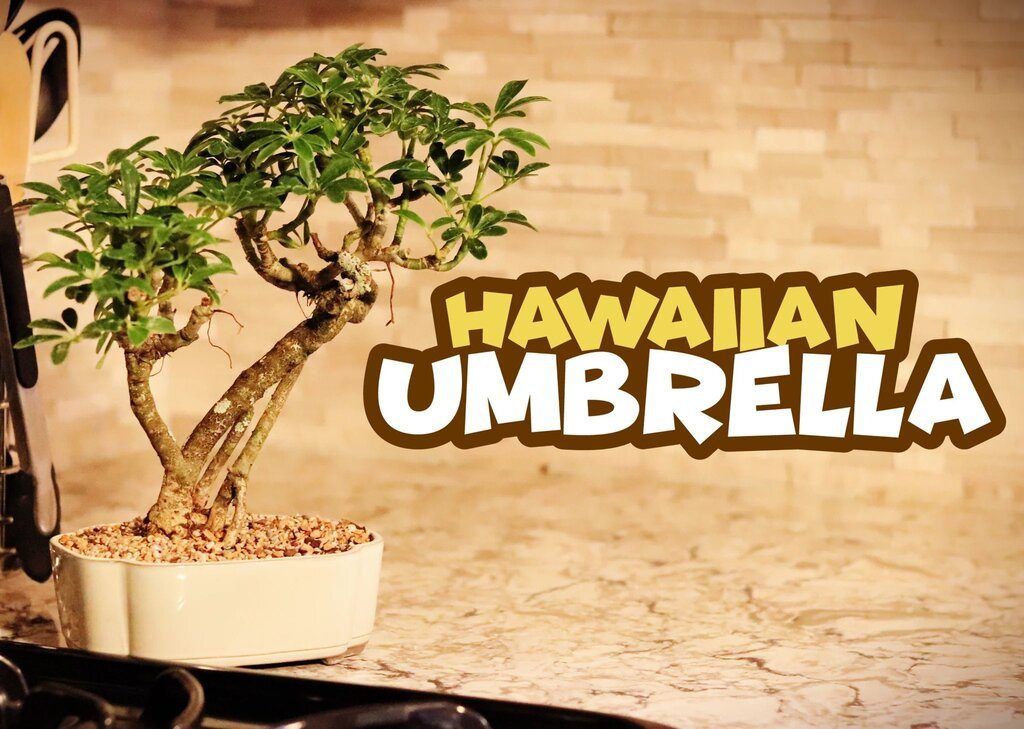- No products in the cart.
The Hawaiian Umbrella Bonsai, also known as Schefflera arboricola, is a stunning plant with a simple upkeep and ability to propagate easily. Belonging to the Araliaceae family, this evergreen boasts dark green foliage that takes on an umbrella shape. The Hawaiian Umbrella Bonsai is an ideal choice for novice growers due to its adaptability to diverse lighting, forgiving watering requirements, and low soil demands. Here are some tips for Hawaiian Umbrella Bonsai care:

Placement
For optimal growth, the Hawaiian Umbrella Bonsai should be placed in a well-lit indoor area with high light during the spring, summer, and fall. During these seasons, the plant benefits from being kept outside. However, when night temperatures dip below 45 degrees Fahrenheit (7°C), the bonsai should be moved indoors and placed on a windowsill or table in front of a window.
During the winter, when nighttime temperatures start approaching 40 degrees Fahrenheit (4°C), the bonsai should be kept indoors. The ideal location for indoor placement is on a south-facing windowsill, with an east or west exposure being the next best option. If the bonsai is placed in a northern exposure, “grow lights” will be needed to supplement natural light and provide sufficient illumination. The bonsai requires at least 4 to 6 hours of sunlight daily, but more is always better.
Watering – A Vital Aspect of Hawaiian Umbrella Bonsai Care
Watering is an essential aspect of caring for your Hawaiian Umbrella Bonsai, and it should never be neglected. It is important to water the plant before the soil appears dry, and never allow the soil to become completely dry. To determine the watering needs of your bonsai, it is advisable to use a moisture meter until you become familiar with your tree’s requirements.
During watering, make sure to apply water until it begins running out of the holes in the bottom of the pot. How you water your bonsai is not as important as ensuring that the plant has been adequately watered by the end of the process.
During the colder months when your Hawaiian Umbrella Bonsai is kept indoors, it is advisable to place it in a shallow tray filled with a layer of gravel and water. This technique helps to increase the moisture levels around the bonsai by utilizing evaporation, which reduces the amount of moisture lost to modern heating systems.
By placing the bonsai on a layer of gravel and water, you can also help to maintain humidity levels around the plant. As the water evaporates, it creates a microclimate around the bonsai that helps to keep the air moist, which is especially important during the dry winter months when indoor heating systems can cause the air to become very dry. It is important to monitor the water level in the tray and add water as needed to ensure that the bonsai has access to sufficient moisture.
Fertilizing
Fertilizing your Hawaiian Umbrella Bonsai is crucial for its health and beauty. As the bonsai grows in a small amount of soil, it is essential to replenish the soil’s nutrient supply regularly. You can use any general-purpose liquid fertilizer, which is readily available at most garden centers. We recommend using fertilizers at half their recommended strength to avoid over-fertilization. Fertilizers should be applied at least once a month, except during winter.
Foliar feeding is another effective method of fertilizing your bonsai. You can use a water-soluble fertilizer every other month and apply it as a spray directly onto the bonsai’s leaves. This method of feeding allows the plant to absorb nutrients through its leaves, which can be beneficial, especially during the growing season.
It is crucial to follow the instructions on the fertilizer packaging and avoid fertilizing your bonsai during the winter months when it is in a dormant state. Over-fertilization can cause damage to the bonsai, so it is always better to err on the side of caution and apply fertilizers at half their recommended strength.

Pruning and Wiring in Hawaiian Umbrella Bonsai Care
Pruning is a crucial aspect of developing a healthy and beautiful Hawaiian Umbrella Bonsai tree. When pruning, it is important to note that new shoots will generally grow in the same direction as the leaf located directly below the cut. By carefully pruning your bonsai, you can encourage the growth of new shoots, increase ramification, and develop smaller leaves.
For very healthy trees, defoliation can be a useful technique to stimulate new growth. To defoliate, simply remove all of the leaves from the tree. At the same time, it is recommended to cut off the tips of the twigs, which will result in lots of new shoots. This process can help to increase ramification, resulting in a fuller and more aesthetically pleasing bonsai.
It is important to note that the Hawaiian Umbrella Bonsai produces no hard wood, so the trunks and branches are likely to snap if bent too strongly. Therefore, it is best to work with younger, more flexible shoots when wiring and shaping your bonsai. With careful pruning and training, you can develop a beautiful and healthy Hawaiian Umbrella Bonsai tree that will be a joy to behold.
Repotting
Periodic repotting is essential for maintaining a healthy bonsai. The process involves removing the tree from its pot, pruning back a portion of the root mass, and placing it in fresh soil. Deciduous trees require repotting every two to three years, while evergreens can go four to five years between repotting. Repotting should be done in mid-summer, and after pruning the root mass, fresh soil should be added to the pot. Care should be taken to avoid leaving any air pockets, and the bonsai should be thoroughly watered after repotting.
Pests and Diseases
Watch out for common pests such as spider mites, mealybugs, and scale insects. These can be treated with insecticidal soap or neem oil. The Hawaiian Umbrella Bonsai is also susceptible to root rot if overwatered, so make sure to check the soil moisture regularly.
Read more:

